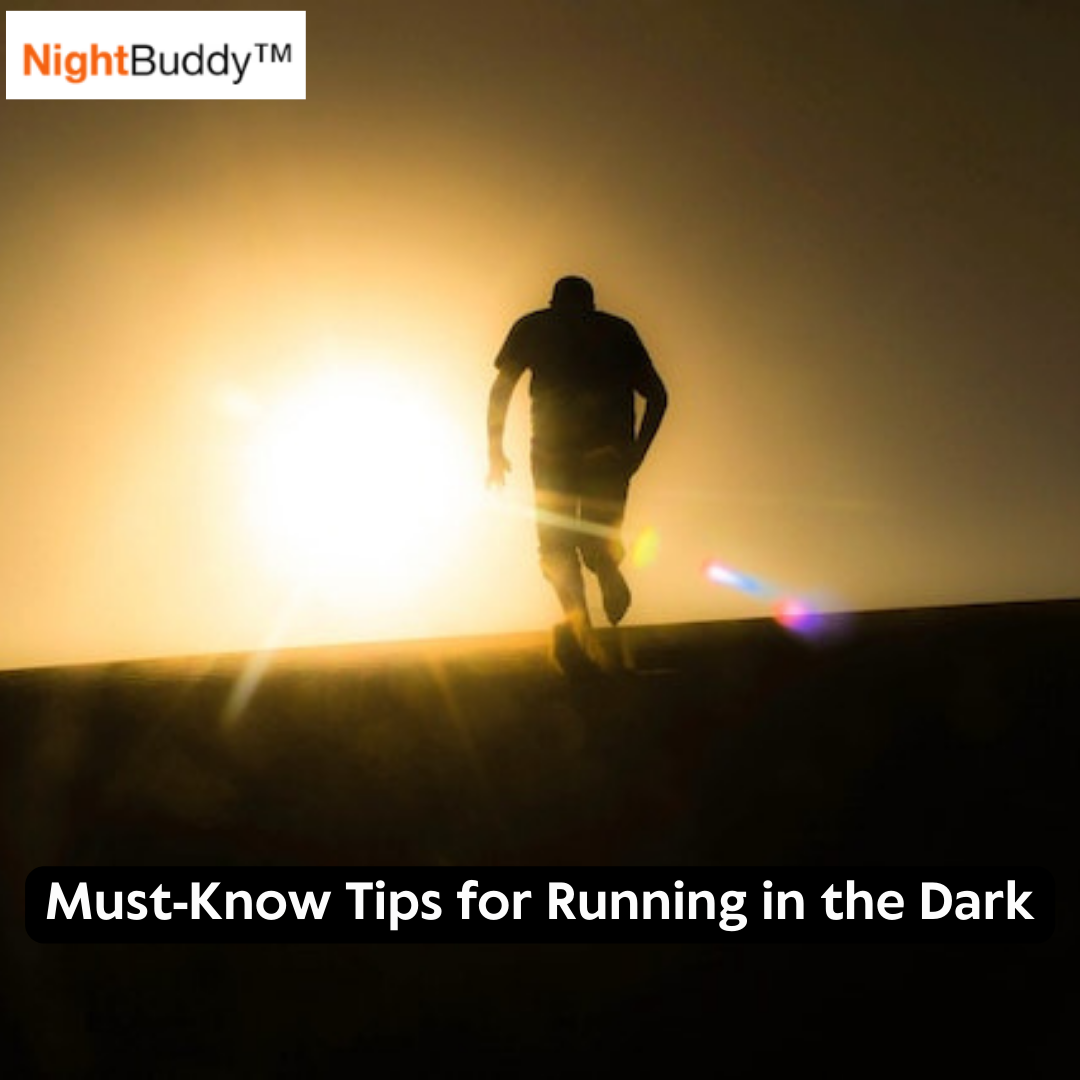Top tips for running in the dark to stay safe whilst burning calories and increasing your fitness levels!
Maybe the only time you can get in a run is early in the morning or late at night because of your schedule and the weather. Then there are the winter months, when you can virtually count on jogging in the dark since the sun has already set by the time you get home from work.
You can safely and confidently enjoy early morning or late evening runs by planning to mitigate the potential dangers that darkness exposes you and many runners to.
To ensure you can enjoy your runs while minimizing the risks, here are 9 tips for running at nighttime from the Night Buddy team;
9 safety tips for running in the dark
It might feel harder to run at night, but here's some top tips from the Night Buddy team;
#1 Wear Reflective Gear
Wearing bright or reflective material when running in the dark can help increase your visibility to drivers, cyclists, and other runners. Even sober drivers may have a hard time seeing you at night or dawn if your clothing isn't visible in the dark.
Some reflective clothing you can consider includes harnesses, vests, belts, arm bands, wrist straps, and tape.
#2 Wear a Headlamp

A running headlamp provides additional light, illuminating the path ahead and helping you see potential obstacles, such as rocks, tree branches, potholes, and uneven pavement, on time.
Drivers and other road users will also be able to spot you from a distance easily. Upon seeing your headlamp, they'll have ample time to slow down or adjust their position on the road.
If you want to carry a light, adjustable, and comfortable headlamp, try NightBuddy™ 230º LED Headlamp. It has powerful illumination of up to 100m, adjustable straps to fit, and wave sensors to turn it on and off hassle-free.
#3 Choose a Well-Lit Route or Populated Area
Choosing to run on well-lit routes can keep you safe in various ways. Such areas allow you to see potential obstacles on the road or sidewalk and avoid them easily.
Areas that are well-lit help you stay alert and aware of your surroundings. In case of danger or an emergency, you can react easily and run to safety immediately.
Populated areas, such as parks or busy roads and streets, provide additional security by ensuring you're visible and not alone in an isolated area.
It's common for bad guys to wait for their prey in dark and desolate places. Avoid being an easy target by keeping off dark alleys!
Also, populated and well-lit areas are more likely to be patrolled by law enforcement or security personnel, providing an added layer of safety.

#4 Find a Running Buddy or Join a Group
Running alone in the dark makes you more vulnerable to potentially dangerous or predatory individuals. When you run with a friend or a group, you reduce your vulnerability and become less of a target for potential criminals.
Besides staying safe, running with someone allows you to enjoy the social and physical benefits of night running. It provides a support system and can help boost motivation, increasing your chances of sticking to your running routine.
#5 Avoid Listening to Loud Music
Music is an excellent company and motivator for most runners, especially when hitting the trails. But when running in the dark, it's best to avoid loud music or noise-canceling headphones.
By doing so, you can remain more aware of traffic and your surroundings, allowing you to hear a passing cyclist or car.
If you must have music when running in the dark, wear only one earbud and keep the volume as low as possible.
You will want to pick up on every sound around you, including a suspicious person approaching or incoming danger.
#6 Change Your Running Routes and Time
Varying your running routes and time is an important safety precaution when running at night. Running the same route at the same time every single day can make you predictable and increase your vulnerability to potential attackers.
By varying your routes and times, you can make it harder for bad elements to target you.
#7 Inform a Trusted Person of Your Route and Running Duration
One of the best safety precautions you should adopt when running a trail in the dark alone is sharing your route details with at least one person before you head out. Tell them your route, starting time, and the approximate duration you'll be out there.
If anything unexpected happens, a trusted friend or family member can act quickly and ensure you get the help needed. You should also notify them once you're done with your running session to avoid creating unnecessary panic.

#8 Run on the Side Facing Traffic
Running on the left side of the road facing oncoming traffic allows you to see and react quickly to approaching vehicles.
Staying on the left side also allows drivers to see you easily. Whether you're wearing reflective running gear, clothes with bright colors, and using a headlamp or not.
#9 Bring Safety Gear, Cell Phone, and Identification
One of the best safety tips for running in the dark is ensuring you're prepared for the worst. If an unfortunate situation arises, you should be able to stay protected while waiting for help.
Read also; The Best Night Running Gear for Summer - Ultimate Guide
Safety gear, such as pepper spray, a personal alarm device, a taser, or a whistle can help you defend yourself or alert others if you need help.
Having a phone with you can help you call for assistance in case of an emergency.
It's also essential to carry identification with emergency contact information in case you are injured or incapacitated during your run.
How to begin your morning workout
If you just don't feel comfortable jogging at night, change your training program so that your run starts shortly after sunrise.
Even if you're not a morning person, changing your routine might be difficult at first. Fortunately, there are certain things you can do to make the transition to a morning run habit simpler.
Here are some Night Buddy pointers for morning runs:
- Lay out your clothing the previous evening
- So that you don't feel hurried after, plan your route, speed, and time
- If you'll be getting up earlier than usual, change the time you go to bed
- Set your alarm to wake up your body and mind in a timely manner
- Before your run, have a small snack like an apple, banana, or half of a bagel
- As you prepare, find a good playlist that motivates you
Final thoughts on running in the dark
Whether you're running in the dark because of busy schedules, limited daylight hours, or other reasons, you should take safety precautions.
Wear reflective gear, bring self-defense items, run facing traffic, share your running route with someone, vary your routes, avoid loud music, run with a friend, and use well-lit routes. Most tips for running in the dark are simple and easy to implement.
If your running routes have lighting issues, use a quality headlamp to light and illuminate your own path and increase visibility to oncoming cars.
We highly recommend the NightBuddy™ 230º LED Headlamp. It checks all the boxes of factors to consider when buying a headlamp.
Are there any benefits of running at night? Find out here about burning fat whilst running at nighttime!





Leave a comment
This site is protected by hCaptcha and the hCaptcha Privacy Policy and Terms of Service apply.